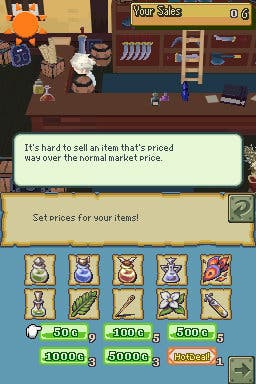Final Fantasy: The 4 Heroes of Light
New-age fun with a retro feel.
Final Fantasy: The 4 Heroes of Light has practically nothing to do with Final Fantasy. Certainly not modern Final Fantasy, in any case. This is nothing new for Square-Enix – you don't have to peer far back into the mists of time to find similar examples – and it's also no bad thing. For many, Final Fantasy has become emblematic of a genre still struggling to find its place in the modern world. Putting the name to a game that's not what you'd expect from it might help to redress that image.
Heroes of Light reacts to its ever-more uncomfortably anachronistic genre by unashamedly retreating into the past, simplifying itself as much as it can and coating itself in sweet nostalgia, with old-fashioned music and calmingly beautiful artistic direction.
Developed by Matrix Software – the same developer that handled the DS remakes of Final Fantasies 3 and 4 – it's devoid of full-motion cut-scenes and self-involved storytelling, level-up menus and ability trees. It stars four childlike but likeable main characters – the usual plucky adolescent, his older, more capable friend, a princess and her protector – who come together and break apart as the story dictates, joined now and then by various short-term companions from fairies and kittens to desert ninjas.

Equipment and abilities are simplified by an inventory system that gives each character 15 spaces for all their books, weapons, armour and recovery items – give any character a staff, a few spell books and a fetching top-hat and they can be a mage. Playing dress-up with different weapons and armour is entertaining in itself – it has nothing like the range of Dragon Quest IX's customisation, but the characters' appearance changes depending on what they have equipped.
15 spaces isn't a terribly large amount, of course, particularly when you only have one or two party members, as you do for almost the first half of the game after the four characters head off in different directions. But managing all of your items and abilities in one unified space cuts down on a lot of the menu-faffing that bloats RPG play-times, and curbs the player's kleptomaniac tendencies. You won't be carrying around that useless but cool-looking but, yeah, useless wind spear for hours before chucking it.
Crowns, the game's substitute for a job system, add a further level of visual and practical customisation. You get two or three new crowns after every significant portion of the story, and as well as making the characters look dashing, they give them targeted ability boosts – a top hat gives extra magic attack power, a fez lets you negotiate better with merchants – along with battle commands like Steal or Berserk. Crowns, as well as weapons, can be upgraded with jewels that you win from defeating monsters in random battles, but it's not a complicated process.


